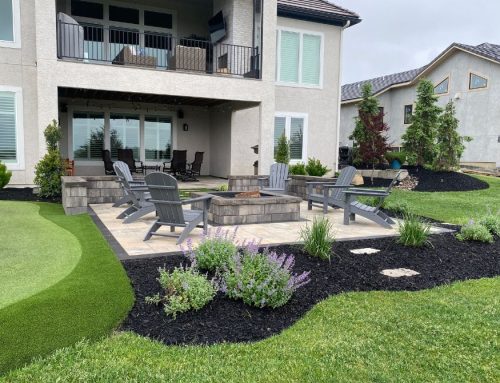Are you considering transforming your outdoor space with artificial grass but need help figuring out where to start? Look no further! In this guide, we’ll dive into the ins and outs of artificial grass installation, exploring why it’s becoming increasingly popular and when the best time to install it in Missouri might be.
What is Artificial Grass?
Artificial grass is typically made from a combination of materials designed to look and feel like natural grass. The primary components include:
- Synthetic Fibers: These fibers are the main component of artificial grass and are typically made from materials like polyethylene, polypropylene, or nylon. These fibers are designed to be durable, UV-resistant, and resilient to heavy foot traffic.
- Backing Material: The backing material provides stability and support for the synthetic fibers. It is usually made from materials like polyurethane or latex, which are coated onto a fabric or mesh backing.
- Infill: Infill is a material sometimes added to the to provide stability, resilience, and support for the fibers. Common infill materials include silica sand, rubber granules, or a combination of both.
- UV Stabilizers: UV stabilizers are often added to to protect the synthetic fibers from fading and degradation from exposure to sunlight.
- Drainage System: Artificial grass typically includes a perforated backing and a drainage system to allow water to drain through the surface efficiently, preventing pooling and water damage. Overall, it is engineered to closely resemble the look and feel of natural grass while offering enhanced durability, low maintenance, and versatility for various applications.
Who Uses Artificial Grass?
Artificial grass isn’t just for professional sports fields anymore. It’s increasingly popular among homeowners, businesses, schools, and municipalities looking to enhance their outdoor spaces. It offers a versatile solution for a range of applications.
- Residential Lawns: Many homeowners choose artificial grass for their lawns to enjoy a lush, green yard year-round without the hassle of mowing, watering, and fertilizing.
- Commercial Landscapes: Artificial grass is popular in commercial settings such as office complexes, shopping centers, and hotels, where maintaining natural grass can be costly and time-consuming.
- Playgrounds and Recreational Areas: Artificial grass provides a safe and durable surface for playgrounds, parks, and recreational areas, offering cushioning for falls and reducing the risk of injuries.
- Sports Fields: Artificial grass is widely used for soccer, football, baseball, and other sports fields. It provides a surface consistent for athletes and stands up to harsh weather and heavy use.
- Putting Greens: Many golf enthusiasts opt for artificial grass putting greens in their backyard or indoor spaces to practice their putting skills without the need for extensive maintenance.
- Dog Runs and Pet Areas: Artificial grass is ideal for pet areas, as it is durable, odor-resistant, stain-resistant, easy to clean, and provides a comfortable and safe outdoor space for pets to play.
- Rooftop Gardens and Balconies: Artificial grass can be installed on rooftops and balconies to create green spaces in urban environments where natural grass is not feasible.
- Landscaping Features: Artificial grass can be used to enhance landscaping features such as pathways, medians, and decorative elements, adding a touch of greenery to outdoor spaces.
Overall, the versatility, durability, and low maintenance requirements make it a popular choice for various applications, from residential landscapes to commercial and recreational areas.
Why Should I Hire a Professional for Installation?
When it comes to installation, hiring a professional is key. Here’s why:
- Quality: Professionals have the expertise and tools to ensure proper installation, producing a high-quality finished product.
- Proper Installation: Improper installation can result in issues like uneven surfaces or drainage problems. Professionals know how to install artificial grass correctly, maximizing its longevity and performance.
- Cost Savings: While there’s an initial cost to hire a professional, the money you can save from avoiding costly mistakes ensures your investment is worth it.
What are the Benefits of Artificial Grass?
Beyond low maintenance and cost savings, installing artificial grass has many other benefits. These include:
- Eco-Friendly: It conserves water and removes the need for harmful pesticides and fertilizers, making it an environmentally friendly choice.
- Pet Friendly: It is pet-friendly and resistant to stains and odors, providing a safe and comfortable outdoor space for your furry friends.
- Looks Great: With advancements in technology, this product looks and feels more realistic than ever, enhancing the aesthetic appeal of any outdoor area.
When Should Artificial Grass Be Installed?
The best time for installation depends on several factors, including:
- Timing: Spring and fall are typically the best seasons for installation, as the weather is mild, and the grass has time to settle before extreme temperatures hit.
- Budget: Consider your budget and schedule installation during a time that works best for you financially.
- Contractor: Be sure to schedule installation with a reputable contractor who can accommodate your timeline and provide quality service.
Wrapping up
Artificial grass installation offers many benefits for homeowners, businesses, and communities. Whether you want to reduce maintenance, save money, or create a pet-friendly environment, this product provides a versatile and sustainable solution for transforming your outdoor space. Be sure to hire a professional to ensure quality and longevity. And, consider timing your installation during the spring or fall for optimal results. Ready to take the leap? Contact Integrity Hardscapes today to learn more about artificial turf installation and start enjoying the benefits of a beautiful, low-maintenance lawn!








